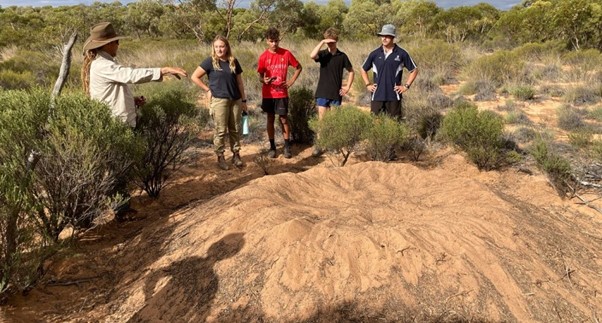A South Australian program which monitors vulnerable malleefowl has won more funding to continue its work into next year.

AWLB Ecologist Brett Backhouse talks about mallee fowl with a group of Year 12 students on a field trip. Photo supplied.
The federal government extended funding for the Alunytjara Wilurara Landscape Board (AWLB)’s malleefowl project to continue until 30 June 2024.
Malleefowl, or Nganamara in Pitjantjatjara, are ground-dwelling birds that are known for their nest mounds.
The mounds can be more than a metre high and several across, and the adult birds maintain incubation temperatures within by adding and removing fallen leaves and soil.
The birds are under threat around the country, with introduced predators like foxes and wild cats and introduced plants like buffel grass encroaching on their ecosystems.
Ecologist Brett Backhouse said the funding extension allows the AWLB to continue its long-term work with the species.
“Short-term projects don’t really give a lot of ecological benefit, while a longer project is more robust and gives much better results for the species,” he said.

Backhouse has been working with the AWLB for seven years and has been on the malleefowl project since it first secured federal funding in 2018.
The funding allows the board to monitor the vulnerable birds as well as threats to the species.
Planes fitted with Light Detection and Ranging (LiDAR) equipment first record detailed imaging of the area’s topography.
“The imaging gets put through an algorithm which helps us to identify potential mounds, and when we find one that’s the right shape we can walk out there and have a look,” Backhouse said.
AWLB staff visit the potential mounds, supported by local Anangu ranger teams, and categorise them as active or non-active.
Backhouse said malleefowl generally live in relatively soft sand, which helps when tracking the bird’s footprints.
“If you’re seeing lots of footprints then at least you know the birds are there,” he said.
“If we’re getting birds at those mounds, you can assume that you’ve got eggs in there.”
A range of monitoring and management techniques are then employed across active malleefowl mound sites.
The AWLB has been trialling automated devices called Felixers, which use AI to identify animals passing in front of them.
These units are used to target and remove cats and foxes while preserving native species.
“We have the benefit of being outside the dog fence, so we’ve got the native dingo which helps keep cats and foxes suppressed a bit,” Backhouse said.
“We want to keep those dingos in place, so we don’t want to do aerial baiting where you can potentially harm a lot of things.”

AWLB Ecologist Brett Backhouse and FWCAC Ranger Ricky Lennon calibrating a Felixer. Photo: supplied
Felixers are used in conjunction with passive trail camera grids, while similar passive camera grids are also installed at known active mounds without Felixers to determine the effectiveness of the devices.
Buffel grass also poses a significant threat to malleefowl, outcompeting native plants and increasing the risk of serious wildfires.
“It’s an introduced weed from South Africa into the Middle East,” Backhouse said.
“It’s very adaptive, it’s very strong, tolerates fire, and it’s a real quick coloniser that could cause some huge problems.”
AWLB’s buffel teams, which include AWLB staff, Anangu ranger groups and contractors, have been controlling the grass through chemical spraying and small-scale burning since 2019.
Backhouse said that the malleefowl serve as an umbrella species and that efforts to protect it also serve to protect other native fauna.
“We’ve got the birds there and it’s one species that you can really work on and see results,” he said.
“But you know that other little mammals, little reptiles and other threatened birds are all getting the benefits of the work you’re doing with the malleefowl.”
AWLB General Manager Kim Krebs said that the program has been effective in safeguarding malleefowl in the region.
“It’s a successful multifaceted approach that must be maintained to continue these positive outcomes into the future,” Krebs said.
“So the funding extension from the Australian government is very welcome.”
Words: Camillo Malacari



